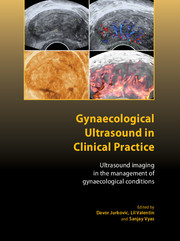 Gynaecological Ultrasound in Clinical Practice
Gynaecological Ultrasound in Clinical Practice Published online by Cambridge University Press: 05 February 2014
Introduction
Pelvic pain is a common gynaecological complaint and ultrasound examination is often performed in an attempt to identify its cause. The ultrasound scan, however, should not be used as a substitute for clinical history and examination. The best use of ultrasound is to confirm or exclude a diagnosis that we suspect on the basis of clinical data. There are several painful conditions that can be seen and diagnosed with ultrasound. This is particularly true of acute painful conditions. However, chronic pelvic pain is a different clinical entity. There is no accepted definition of chronic pelvic pain and there is much controversy about what conditions may explain it. Some conditions that have been suggested to cause chronic pelvic pain, such as neuralgia or irritable bowel syndrome, cannot be visualised by transvaginal ultrasound.
Acute pelvic pain
Adnexal cysts
Adnexal cysts are common incidental ultrasound findings both in pre-and postmenopausal asymptomatic women. Cysts larger than 25 mm are found at ultrasound examination in 7% of asymptomatic premenopausal women and cysts larger than 15 mm are found in about 7% of postmenopausal women. Thus, if we detect a cyst at ultrasound examination in a woman with pelvic pain, the cyst is not necessarily the cause of her pain. If we can provoke her pain or make it worse by pushing on the cyst with the vaginal ultrasound probe or with our outer free hand, then there is likely to be a relationship between the cyst and the pain.
To save this book to your Kindle, first ensure [email protected] is added to your Approved Personal Document E-mail List under your Personal Document Settings on the Manage Your Content and Devices page of your Amazon account. Then enter the ‘name’ part of your Kindle email address below. Find out more about saving to your Kindle.
Note you can select to save to either the @free.kindle.com or @kindle.com variations. ‘@free.kindle.com’ emails are free but can only be saved to your device when it is connected to wi-fi. ‘@kindle.com’ emails can be delivered even when you are not connected to wi-fi, but note that service fees apply.
Find out more about the Kindle Personal Document Service.
To save content items to your account, please confirm that you agree to abide by our usage policies. If this is the first time you use this feature, you will be asked to authorise Cambridge Core to connect with your account. Find out more about saving content to Dropbox.
To save content items to your account, please confirm that you agree to abide by our usage policies. If this is the first time you use this feature, you will be asked to authorise Cambridge Core to connect with your account. Find out more about saving content to Google Drive.